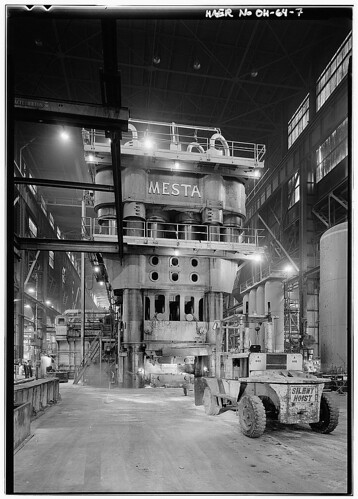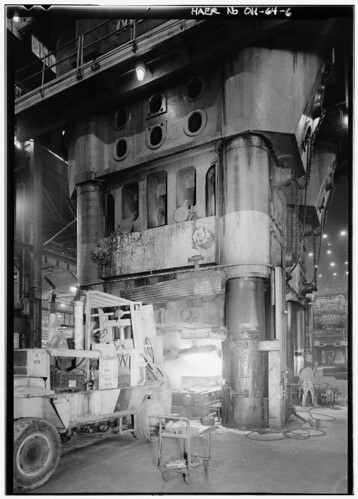
When I first heard about the damage to the 50,000 ton Mesta press at the Alcoa works in Cleveland, my reaction was minimal. It sounded like yet another attempt to retain some small bit of the once great industrial heart that made Cleveland what it is today. I had seen the Historic American Engineering Record's documentation of the press, but again, I didn't know the current significance of the it.
The 50,000 ton Mesta Press has been designated a Mechanical Engineering Landmark by the American Society of Mechanical Engineers (ASME), one of about 250 sites worldwide to recieve this recognition. Their brochure for the dedication ceremony helps explain the historical significance of the press in the history of the Cleveland and the aerospace industry.
The 1981 program provides the following background:
The Mesta 50,000 ton hydraulic closed die forging press, this country’s largest forging machine, is currently producing the largest light metal forgings in the world.
This massive forging tool actually had its genesis during the days of World War II. Allied intelligence teams inspecting German aircraft downed behind our lines discovered that they contained extremely large and complex major structural elements. Our appraisal of the situation, confirmed immediately after the end of the war, was that the Germans had produced these aircraft components with the aid of huge forging and extrusion presses possessing capabilities far in excess of those in our own industrial complex.
The implications were far-reaching. If forgings and extrusions large enough to comprise key aircraft structural elements could be produced in this country, not only would fabrication time be reduced greatly, but costs would be lowered. In addition, such a technique held the promise of forging materials with greater strength-weight ratios, an extremely desirable attribute from the standpoint of aircraft design. Just before the conclusion of the war, the United States embarked upon an urgent program to build a press able to match our estimates of the productive capability of the German equipment. The Mesta Machine Company of Pittsburgh was awarded a contract to construct an 18,000 ton forging press, and the Wyman Gordon Company of North Grafton, Massachusetts, was selected to operate it. Since the press was so enormous, a pattern to be followed when the press program went into full swing was established — a plant had to be built around the press to
house both it and its supporting equipment. The war ended, however, before the project was fully completed.
When our technical/industrial teams visited Germany after the cessation of hostilities, they found that the Germans had indeed developed and learned successfully to operate presses ranging up to 30,000 metric tons. In all, three heavy die forging presses, two with a capacity of 15,000 metric tons and one with a 30,000-ton capacity, were discovered in more or less useable condition. Three extrusion presses in the 5,000 metric ton category were also located. As part of the postwar settlement, the United States acquired the 15,000 and 5,000 metric ton presses which were channeled into the Air Force Heavy Press Program. The 30,000-ton press, however, was seized by the Russians. With the Soviets in possession of so large a press, our Heavy Press Program received added impetus.

As of November, it seems that the press will be rebuilt. I don't see what other options ALCOA has with regard to the matter. The press has produced some of the largest single structural elements for air and spacecraft. These are parts that simply cannot be produced in any other facilities.
The 50,000 ton Mesta Press should be seen as a vital element in the history of industrial Cleveland, as significant as the Hulett Ore Unloaders.




No comments:
Post a Comment